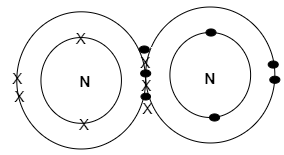
How many numbers of electrons are involved in the formation of a nitrogen molecule?
A. Three
B. Four
C. Eight
D. Six
Answer
483.6k+ views
1 likes
Hint: Try to first explain about the electronic configuration of nitrogen atoms and then recall the structural formula of a nitrogen molecule. Nitrogen is a non-metal and it has five electrons in its outer shell.
Complete answer:
We know that the atomic number of nitrogen is
When two nitrogen atoms will react, three electrons (from five valence electrons) of each nitrogen atom are shared between them so that both will obtain a stable configuration. By sharing six electrons where the outer shell touches each nitrogen atom will count eight electrons (stable configuration). The full outer shells with the shared electrons are now stable forming a covalent bond and this can be shown through the following diagram:

Thus, in total six electrons are involved in the formation of a nitrogen molecule (
Hence, the correct option is D.
Note: Molecular nitrogen (
Complete answer:
We know that the atomic number of nitrogen is
When two nitrogen atoms will react, three electrons (from five valence electrons) of each nitrogen atom are shared between them so that both will obtain a stable configuration. By sharing six electrons where the outer shell touches each nitrogen atom will count eight electrons (stable configuration). The full outer shells with the shared electrons are now stable forming a covalent bond and this can be shown through the following diagram:

Thus, in total six electrons are involved in the formation of a nitrogen molecule (
Hence, the correct option is D.
Note: Molecular nitrogen (
Latest Vedantu courses for you
Grade 11 Science PCM | CBSE | SCHOOL | English
CBSE (2025-26)
School Full course for CBSE students
₹41,848 per year
Recently Updated Pages
Master Class 11 Economics: Engaging Questions & Answers for Success

Master Class 11 Business Studies: Engaging Questions & Answers for Success

Master Class 11 Accountancy: Engaging Questions & Answers for Success

Master Class 11 English: Engaging Questions & Answers for Success

Master Class 11 Computer Science: Engaging Questions & Answers for Success

Master Class 11 Maths: Engaging Questions & Answers for Success

Trending doubts
State and prove Bernoullis theorem class 11 physics CBSE

1 ton equals to A 100 kg B 1000 kg C 10 kg D 10000 class 11 physics CBSE

State the laws of reflection of light

One Metric ton is equal to kg A 10000 B 1000 C 100 class 11 physics CBSE

1 Quintal is equal to a 110 kg b 10 kg c 100kg d 1000 class 11 physics CBSE

Difference Between Prokaryotic Cells and Eukaryotic Cells




